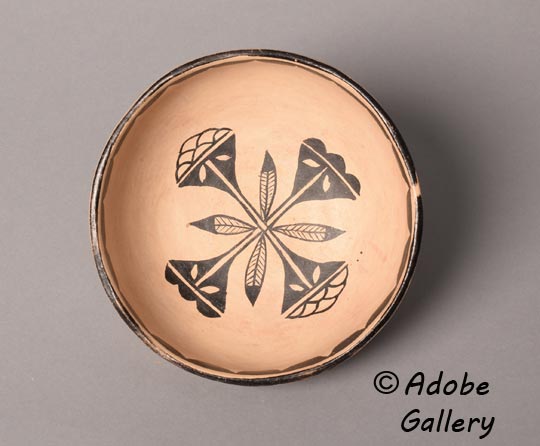Historic Cochiti Pueblo Serving Bowl with Micaceous Paste
+ Add to my watchlist Forward to Friend
Forward to Friend
- Category: Historic
- Origin: Cochiti Pueblo, KO-TYIT
- Medium: clay, pigment
- Size: 3” deep x 7-¾” diameter
- Item # C4933ZE
- Price: $1250
This beautiful small serving bowl, dating to circa 1930, is a pristine example of historic Pueblo pottery. It was most likely sold shortly after creation, as there is no evidence of use, and both the interior and exterior designs are in excellent condition.
Design and Symbolism
The bowl's designs are rich with cultural meaning. The pattern running around the interior rim represents clouds, acting as a visual prayer or plea for rain to nourish the community's crops. The design on the interior bottom is a traditional Cochiti pattern, used for many decades, likely symbolizing four rain clouds delivering life-giving moisture to the plants below.
The black pigment used for these designs is traditionally made by boiling the leaves of the Rocky Mountain Bee plant, yielding a solid form that becomes liquid paint when touched with a wet brush. The exterior of the bowl subtly emphasizes this material with a black band outlining numerous Bee plant leaves.
The unpainted underside of the bowl offers a beautiful display of micaceous material, which was mixed with the clay.
The Historic Budaghers Clay
The cream-colored slip on the interior and exterior is the original, high-quality clay source used by potters at Cochiti and Kewa (formerly Santo Domingo) Pueblos for decades. This white clay was sourced from a location south of Santa Fe along Route 66 known as Budaghers.
From the 1950s to the 1960s, the Budaghers Trading Post, run by Joseph and Sally Budaghers, permitted local Native American potters to dig the crucial white clay at their site.
The Impact of Modernization
The construction of Interstate 25 in the 1960s effectively abolished the original alignment of Route 66 in that area, consuming the Budaghers location. Although potters continued to mine the site for a number of years, the area was eventually fenced off and made inaccessible.
This loss was devastating for potters. Artists like Robert Tenorio of Kewa Pueblo spent considerable time searching and experimenting with new white clays, but none matched the quality of the old source. While some potters followed his lead, others, particularly at Cochiti Pueblo, were so dissatisfied with the new clay that many ultimately ceased making pottery altogether.
The change in the highway, ironically implemented for easier travel (the original Route 66 road at Budaghers was so steep that Model T Fords sometimes had to back up the hill), permanently altered the local pottery tradition by eliminating the source of their most cherished material. This bowl, therefore, represents a period of ceramic excellence before that historic clay source was lost.
Condition: very good condition with no repairs or overpaint
Provenance: this Historic Cochiti Pueblo Serving Bowl with Micaceous Paste is from a client of Adobe Gallery
Recommended Reading: A River Apart, The Pottery of Cochiti & Santo Domingo Pueblos, Publisher - Museum of Indian Arts & Culture, Santa Fe, 2008
TAGS: Southwest Indian Pottery, Cochiti Pueblo, Historic Pottery

- Category: Historic
- Origin: Cochiti Pueblo, KO-TYIT
- Medium: clay, pigment
- Size: 3” deep x 7-¾” diameter
- Item # C4933ZE
- Price: $1250
Adobe Gallery Recommended Reading
Adobe Gallery Recommended Items
If you are interested in this item, we would also like to recommend these other related items:



